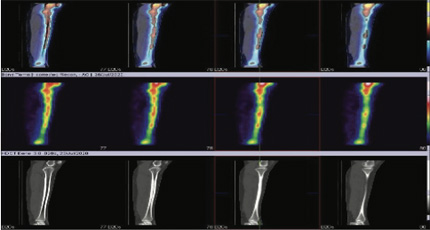Tibial Stress Syndrome is also known as shin splints or tibial periostitis. These injuries are commonly suffered by those athletes who engage in running sports or basic activities such as cross country, football, or hiking. The main characteristic of Tibial Stress Syndrome is pain in the lower part of the leg between the knee and the ankle. Repeated trauma to the connective muscle tissue surrounding the tibia brings about Tibial Stress Syndrome injuries. This may result in more serious conditions, if left untreated or ignored, such as stress fracture of the bones.
Tibial Stress Syndrome can be attributed to overloading the muscles of the lower extremities or biomechanical irregularities. Muscle imbalance, including weakened core muscles lead to lower-extremity injuries; also, the inflexibility and tightness of the gastrocnemius, soleus, and plantar muscles (commonly the flexor digitorum longus) can contribute to tibial stress syndrome. Increasing activity, intensity, and duration too quickly leads to medial tibial stress syndrome or shin splints because the tendons and muscles are unable to absorb the impact of the shock force as they become fatigued; also, the tibial bone-remodeling capabilities are overloaded. Some experts believe that this pain is caused from disruption of Sharpey’s fibres that connect the medial soleus fascia through the periosteum of the tibia to insert into the bone. With repetitive stress, the impact forces eccentrically fatigue the soleus and create repeated tibial bending or bowing; thus, contributing to Tibial Stress Syndrome. The impact is made worse by running uphill, downhill, on uneven terrain, or on hard surfaces. Improper footwear, including worn-out shoes can also contribute to medial tibial stress syndrome.
Tibial Stress Syndrome or Shin Splints typically presents as pain in the front of the outer leg below the knee. The pain of medial tibial stress syndrome is characteristically located on the outer edge of the mid region of the leg next to the shinbone (tibia). An area of discomfort measuring 4 to 6 inches (10 to 15 cm) in length is frequently present. Shin splint discomfort is often described as dull at first. However, with continuing trauma, the pain can become so extreme as to cause the athlete to stop workouts altogether.
3-phase bone scan indications exclude stress fracture findings Diffuse, longitudinal / linearly increased uptake of varying tracer uptake intensities that involve one-third or more of the posterior tibial cortex in delayed bone phase (Phase 3), Normal findings on Phase 1 (flow phase) and Blood pool phase (Phase 2) differentiate from stress fracture, which has focal, intense hyper perfusion and hyperemia in Phase 1 and 2, and focal, fusiform uptake in Phase 3
26 years old female with history of severe below knee pain on left side and to a lesser degree on right side since last three weeks. History of jogging and skip ropes. Clinically very tender over mid shaft tibia on the right side and lesser degree on the left side.
X-rays left tibia & fibula - Unremarkable.
Phase 1 (Blood pool)- No obvious abnormal pooling of tracer (fig 1) Phase 2 (Bone) Static & SPECT CT FUSED IMAGES shows diffuse longitudinally increased tracer uptakes in upper 2/3rd of both the tibial shaft (right >left) and appreciated in SPECT CT FUSED images (fig 1,2,3,4) & underlying CT Images shows focal cortical thickening of both mid shafts of Tibia along the medial and posterior aspects (fig 5,6,7) favors bilateral tibial stress syndrome / shin splints.
15 years old female with history of pain in both tibial shin for one month. History of running and jogging.
X-rays-Normal.
Bone scan (Static & SPECT CT fused images)-shows longitudinally increased tracer uptakes predominantly in mid shaft of both the tibia, more so seen in postero-medial portions (right>left) favours bilateral shin splints (fig 1,2).
It shows diffuse longitudinally increased tracer uptakes in posterior-medial portion of both mid shaft tibia, favors bilateral shin splints (fig 1)
It shows longitudinally increased tracer uptakes in Right - portion of upper, portion of mid & lower portion with varying tracer uptake intensities posterior-medially.
Left-portion of upper and portion of lower posterior-medially, favors bilateral shin splints (right>left) (fig 1,2).



Tibial stress syndrome or Shin splints are the name often given to exercise-induced pain in the lower leg, specifically along the front of the leg between the knee and the ankle - the area known as the shin.

Figure1: Blood pool images (upper row) & Bone images of legs (lower row)

Figure 2: SPECT-CT fused images (anterior to posterior)

Figure 3: SPECT-CT fused images (right sagittal view)

Figure 4

Figure 5

Figure 6

Figure 7
Fugure 4: SPECT-CT fused images (left sagittal view)
Figure 5, 6, 7: CT images shows focal cortical thickening of both mid shafts of tibia along the medial and posterior aspect
Phase 1 (Blood pool)- No obvious abnormal pooling of tracer (fig 1) Phase 2 (Bone) Static & SPECT CT FUSED IMAGES shows diffuse longitudinally increased tracer uptakes in upper 2/3rd of both the tibial shaft (right >left) and appreciated in SPECT CT FUSED images (fig 1,2,3,4) & underlying CT Images shows focal cortical thickening of both mid shafts of Tibia along the medial and posterior aspects (fig 5,6,7) favors bilateral tibial stress syndrome / shin splints.

Figure 1: Bone images of legs (lower row)

Figure 2: SPECT-CT fused images (three views)

Figure 1: Bone images of legs (lower row)
It shows diffuse longitudinally increased tracer uptakes in posterior-medial portion of both mid shaft tibia, favors bilateral shin splints (fig 1).

Figure 1: Blood pool images (left) & Bone images of legs (right)
It shows longitudinally increased tracer uptakes in Right - portion of upper, portion of mid and lower portion with varying tracer uptake intensities posterior-medially Left-portion of upper and portion of lower posterior-medially , favors bilateral shin splints (right>left) (fig 1,2).

Figure 2: 3D Image